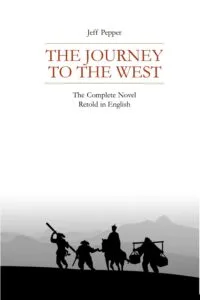A long, long time ago, in a magical version of ancient China, an island called Aolai stood in the sea like a king in his palace. In the center of the island was Flower Fruit Mountain, and at the very top of the mountain was a large stone, as tall as six men. The stone was made pregnant by heaven and earth, and one day the wind blew over the egg and it cracked open. A little stone monkey emerged. He opened his eyes, and two beams of light shot up to heaven. The Jade Emperor on his throne saw the beams of light but he did not interfere.
The little stone monkey grew up to be Sun Wukong, the Handsome Monkey King.
The full story of Sun Wukong’s adventures is told in Journey to the West, an epic 2,000-page novel written in the 16th century by Wu Cheng’en. It’s probably the most famous and best-loved novel in China and is considered one of the four great classical novels of Chinese literature. Its place in Chinese literature is roughly comparable to Homer’s epic poem The Odyssey in Western literature. Wikipedia sums up the book’s role perfectly, saying, “Enduringly popular, the tale is at once a comic adventure story, a humorous satire of Chinese bureaucracy, a spring of spiritual insight, and an extended allegory in which the group of pilgrims journeys towards enlightenment by the power and virtue of cooperation.”
The original Journey to the West is a very, very long story, consisting of a hundred chapters. It is loosely based on an actual journey by the Buddhist monk Xuanzang who traveled from the Chinese city of Chang’an westward to India in 629 A.D. and returned 17 years later with priceless knowledge and texts of Buddhism. Over the course of the book Xuanzang and his companions face the 81 tribulations that Xuanzang had to endure to attain Buddhahood.
This book is not a literal translation of Journey to the West. Rather, it’s a retelling of the story in easy-to-read English. Unlike the other full-text translations, this is a graded reader that uses a restricted vocabulary, simpler sentence structure, and fewer proper nouns. The chapters start off quite easy and gradually increase in complexity. The authors have made every effort to remain faithful to the original while retelling it in simple language.
A GUIDE TO DIFFERENT FORMATS
This easy-to-read retelling of The Journey to the West is available in several different formats, depending on what you’re looking for. They are listed below, along with links to their pages on Amazon. You can also purchase these books directly from us, here. And most of these books are available from major online sellers, including bn.com and walmart.com.
English only:
> Paperback and ebook – the original cover
> Paperback and ebook – same book but with a more colorful cover
Simplified Chinese only:
Simplified Chinese, pinyin and English:
> hardcover – this is an large”coffee table book”
> ebook
31 individual books in Simplified Chinese, pinyin and English:
> Paperbacks and ebooks – to see the list of books
31 individual books in Traditional Chinese, pinyin and English:
> Paperbacks – to see the list of books
11 compilations in Simplified Chinese, pinyin and English:
> each compilation contains 2 or 3 individual books
> Paperbacks – scroll to the bottom and click “show all”

 info@imagin8press.com
info@imagin8press.com